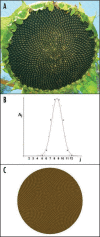Phyllotaxis as an example of the symbiosis of mechanical forces and biochemical processes in living tissue
- PMID: 19704477
- PMCID: PMC2634505
- DOI: 10.4161/psb.3.8.6223
Phyllotaxis as an example of the symbiosis of mechanical forces and biochemical processes in living tissue
Abstract
Phyllotaxis, the arrangement of a plant's phylla (flowers, bracts, stickers) near its shoot apical meristem (SAM), has intrigued natural scientists for centuries. Even today, the reasons for the observed patterns and their special properties, the physical and chemical mechanisms which give rise to strikingly similar configurations in a wide variety of plants, the almost-constant golden divergence angle, the almost constant plastichrone ratio, the choices of parastichy numbers and the prevalence of Fibonacci sequences to which these numbers belong, are at best only partially understood. Our goals in this Addendum are: To give a brief overview of current thinking on possible mechanisms for primordia (the bumps on the plant surface which eventually mature into fully developed structures such as leaves or florets) formation and give a descriptive narrative of the mathematical models which encode various hypotheses.To emphasize the point that patterns, whether they be phyllotactic configurations on plant surfaces or convection cells on the sun's surface, are macroscopic objects whose behaviors are determined more by symmetries of the proposed model and less by microscopic details. Because of this, the identification of observations with the predications of a particular model can only be made with confidence when the match coincides over a range of circumstances and parameters.To discuss some of the key results of the proposed models and, in particular, introduce the prediction of a new and, in principle, measurable invariant in plant phyllotaxis.To introduce a new model of primordia formation which is more in keeping with the pictures and paradigms of Hofmeister,1 Snow & Snow,2 and Douady and Couder3,4 which see primordia as forming in a fairly narrow annular zone surrounding the plant's SAM separating a region of undifferentiated cells from a fully developed patterned state.To consider the challenge of phyllotaxis in the broader context of pattern formation in biological tissue which responds to both mechanical and biochemical processes.
Keywords: PIN1; auxin; biomechanics; growth; pattern formation; phyllotaxis.
Figures

Comment on
-
Phyllotaxis: cooperation and competition between mechanical and biochemical processes.J Theor Biol. 2008 Apr 7;251(3):421-39. doi: 10.1016/j.jtbi.2007.11.036. Epub 2007 Dec 8. J Theor Biol. 2008. PMID: 18207165
References
-
- Hofmeister W. Allgemeine Morphologie der Gewachse, Handbuch der Physiologischen Botanik. Leipzig: Engelmann; 1868. (Ger).
-
- Snow M, Snow R. Minimum areas and leaf determination. Proc R Soc B. 1952;139:545–566. - PubMed
-
- Douady S, Couder Y. Phyllotaxis as a dynamical self-organizing process I. The spiral modes resulting from time-periodic iterations. J Theor Biol. 1996;178:255–274.
-
- Douady S, Couder Y. Phyllotaxis as a dynamical self-organizing process II. The spontaneous formation of a periodicity and the coexistance of spiral and whorled patterns. J Theor Biol. 1996;178:295–312.
-
- Fleming AJ, McQueen-Mason S, Mandel T, Kuhlemeier C. Induction of leaf primordia by the cell wall protein expansin. Science. 1997;276:1415–1418.
LinkOut - more resources
Full Text Sources
Miscellaneous
